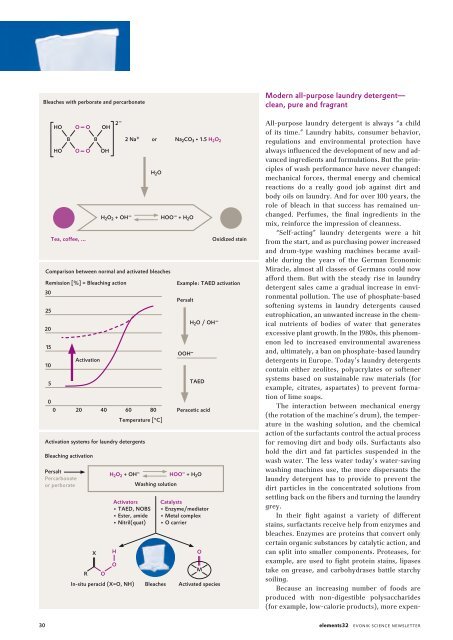Download - Evonik Industries
Download - Evonik Industries
Download - Evonik Industries
You also want an ePaper? Increase the reach of your titles
YUMPU automatically turns print PDFs into web optimized ePapers that Google loves.
Bleaches with perborate and percarbonate<br />
Comparison between normal and activated bleaches<br />
Remission [%] = Bleaching action<br />
30<br />
25<br />
20<br />
15<br />
10<br />
5<br />
0<br />
HO<br />
HO<br />
O O<br />
B B<br />
O O<br />
Tea, coffee, ...<br />
Activation<br />
OH<br />
OH<br />
2 –<br />
2 Na +<br />
Activation systems for laundry detergents<br />
or Na 2CO 3 • 1.5 H 2O 2<br />
H 2O<br />
H 2O 2 + OH – HOO – + H 2O<br />
0 20 40 60 80<br />
Bleaching activation<br />
Persalt<br />
Percarbonate<br />
or perborate<br />
R<br />
X<br />
O<br />
Temperature [°C]<br />
Oxidized stain<br />
Example: TAED activation<br />
Persalt<br />
OOH –<br />
H 2O / OH –<br />
TAED<br />
Peracetic acid<br />
H 2O 2 + OH – HOO – + H 2O<br />
Activators<br />
• TAED, NOBS<br />
• Ester, amide<br />
• Nitril(quat)<br />
H<br />
O<br />
Washing solution<br />
Catalysts<br />
• Enzyme/mediator<br />
• Metal complex<br />
• O carrier<br />
In-situ peracid (X=O, NH) Bleaches<br />
Activated species<br />
O<br />
M<br />
Modern all-purpose laundry detergent—<br />
clean, pure and fragrant<br />
All-purpose laundry detergent is always “a child<br />
of its time.” Laundry habits, consumer behavior,<br />
re gulations and environmental protection have<br />
always influenced the development of new and advanced<br />
ingredients and formulations. But the principles<br />
of wash performance have never chang ed:<br />
mechanical forces, thermal energy and chemical<br />
reactions do a really good job against dirt and<br />
body oils on laundry. And for over 100 years, the<br />
role of bleach in that success has remained unchanged.<br />
Perfumes, the final ingredients in the<br />
mix, reinforce the impression of cleanness.<br />
“Self-acting” laundry detergents were a hit<br />
from the start, and as purchasing power increased<br />
and drum-type washing machines became available<br />
during the years of the German Economic<br />
Miracle, almost all classes of Germans could now<br />
afford them. But with the steady rise in laundry<br />
detergent sales came a gradual increase in environmental<br />
pollution. The use of phosphate-based<br />
softening systems in laundry detergents caused<br />
eutrophication, an unwanted increase in the chemical<br />
nutrients of bodies of water that generates<br />
excessive plant growth. In the 1980s, this phenomenon<br />
led to increased environmental awareness<br />
and, ultimately, a ban on phosphate-based laundry<br />
detergents in Europe. Today’s laundry detergents<br />
contain either zeolites, polyacrylates or softener<br />
systems based on sustainable raw materials (for<br />
example, citrates, aspartates) to prevent formation<br />
of lime soaps.<br />
The interaction between mechanical energy<br />
(the rotation of the machine’s drum), the temperature<br />
in the washing solution, and the chemical<br />
action of the surfactants control the actual process<br />
for removing dirt and body oils. Surfactants also<br />
hold the dirt and fat particles suspended in the<br />
wash water. The less water today’s water-saving<br />
washing machines use, the more dispersants the<br />
laundry detergent has to provide to prevent the<br />
dirt particles in the concentrated solutions from<br />
settling back on the fibers and turning the laundry<br />
grey.<br />
In their fight against a variety of different<br />
stains, surfactants receive help from enzymes and<br />
bleaches. Enzymes are proteins that convert only<br />
certain organic substances by catalytic action, and<br />
can split into smaller components. Proteases, for<br />
example, are used to fight protein stains, lipases<br />
take on grease, and carbohydrases battle starchy<br />
soiling.<br />
Because an increasing number of foods are<br />
pro duced with non-digestible polysaccharides<br />
(for example, low-calorie products), more expen-<br />
30 elements32 evonik science newsletter

















